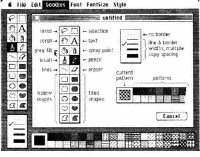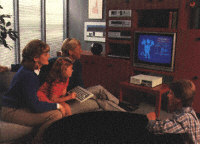|
|


 Apple Macintosh
Apple Macintosh
|
|
Computers
Apple Computer launched the Macintosh, the first successful mouse-driven
computer with a graphic user interface, with a single $1.5 million commercial
during the 1984 Super Bowl. Based on the Motorola 68000 microprocessor, the
Macintosh included many of the Lisa's features at a much more affordable price:
$2,500.
Apple's commercial played on the theme of George Orwell's "1984" and
featured the destruction of Big Brother with the power of personal computing
found in a Macintosh. Applications that came as part of the package included
MacPaint, which made use of the mouse, and MacWrite, which demonstrated WYSIWYG
(What You See Is What You Get)
word processing.

|
|
|
|
|
Components
Sony introduced and shipped the first 3 1/2" floppy drives and diskettes
in 1981. The first signficant company to adopt the 3 1/2" floppy for
general use was Hewlett-Packard in 1982, an event which was critical in
establishing momentum for the 3 1/2" format and which helped it prevail
over the other contenders for the microfloppy standard, including 3 1/4",
3", and 3.9" formats.

|
|
|
 IBM PC Jr.
IBM PC Jr.
|
|
Computers
IBM released its PC Jr. and PC-AT. The PC Jr. failed, but the PC-AT, several
times faster than original PC and based on the Intel 80286 chip, claimed
success with its notable increases in performance and storage capacity, all for
about $4,000. It also included more RAM and accommodated high-density
1.2-megabyte 5 1/4-inch floppy disks.

|
|
|
 Gibson's "Neuromancer"
Gibson's "Neuromancer"
|
|
People & Pop Culture
In his novel "Neuromancer," William Gibson coined the term
"cyberspace." He also spawned a genre of fiction known as
"cyberpunk" in his book, which described a dark, complex future
filled with intelligent machines, computer viruses, and paranoia.
Gibson introduced cyberspace as: "A consensual hallucination
experienced daily by billions of legitimate operators, in every nation, by
children being taught mathematical concepts... A graphic representation of
data abstracted from the banks of every computer in the human system.
Unthinkable complexity. Lines of light ranged in the nonspace of the mind,
clusters and constellations of data. Like city lights,
receding..." (p. 51).

|

|
|

|
|
